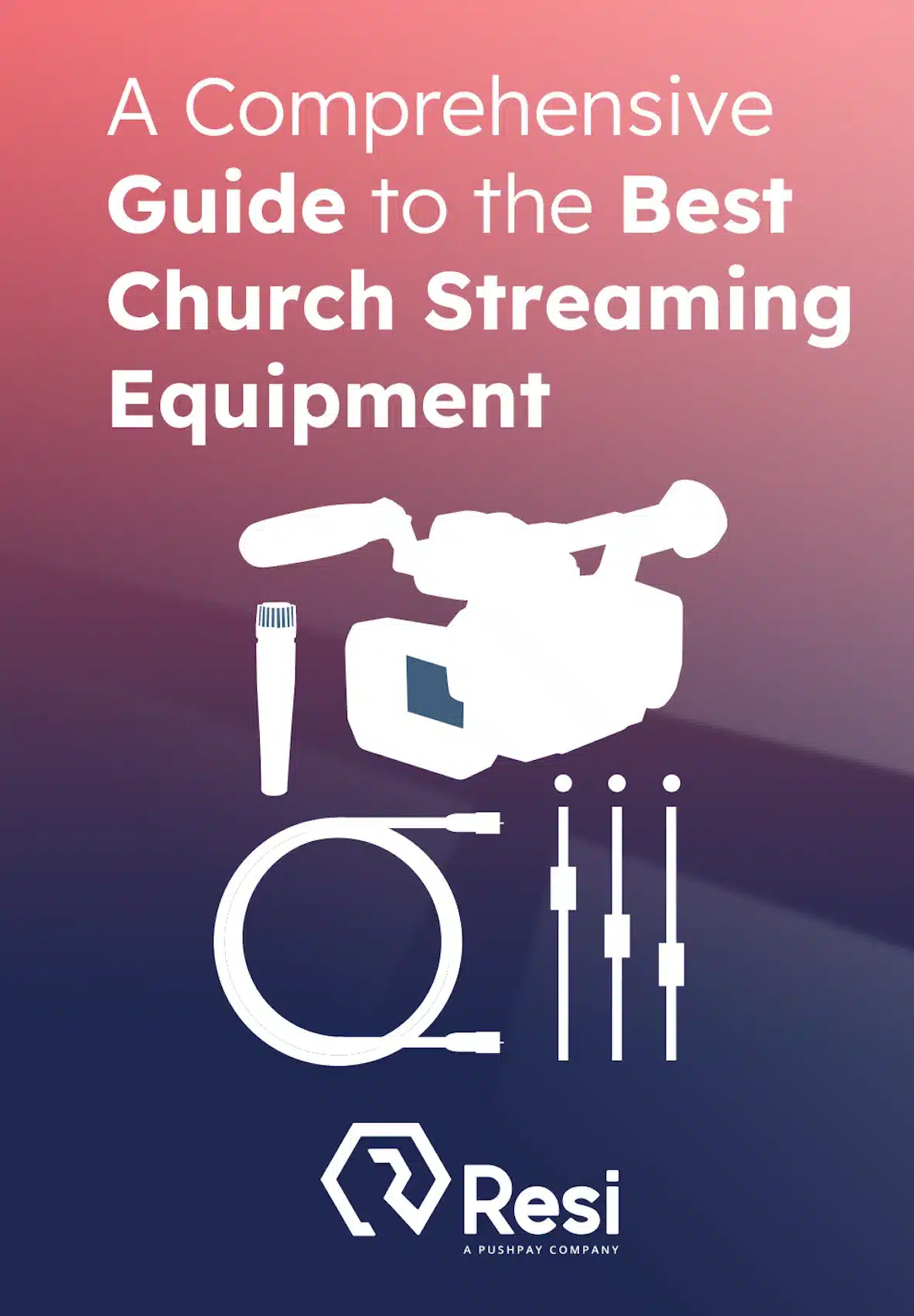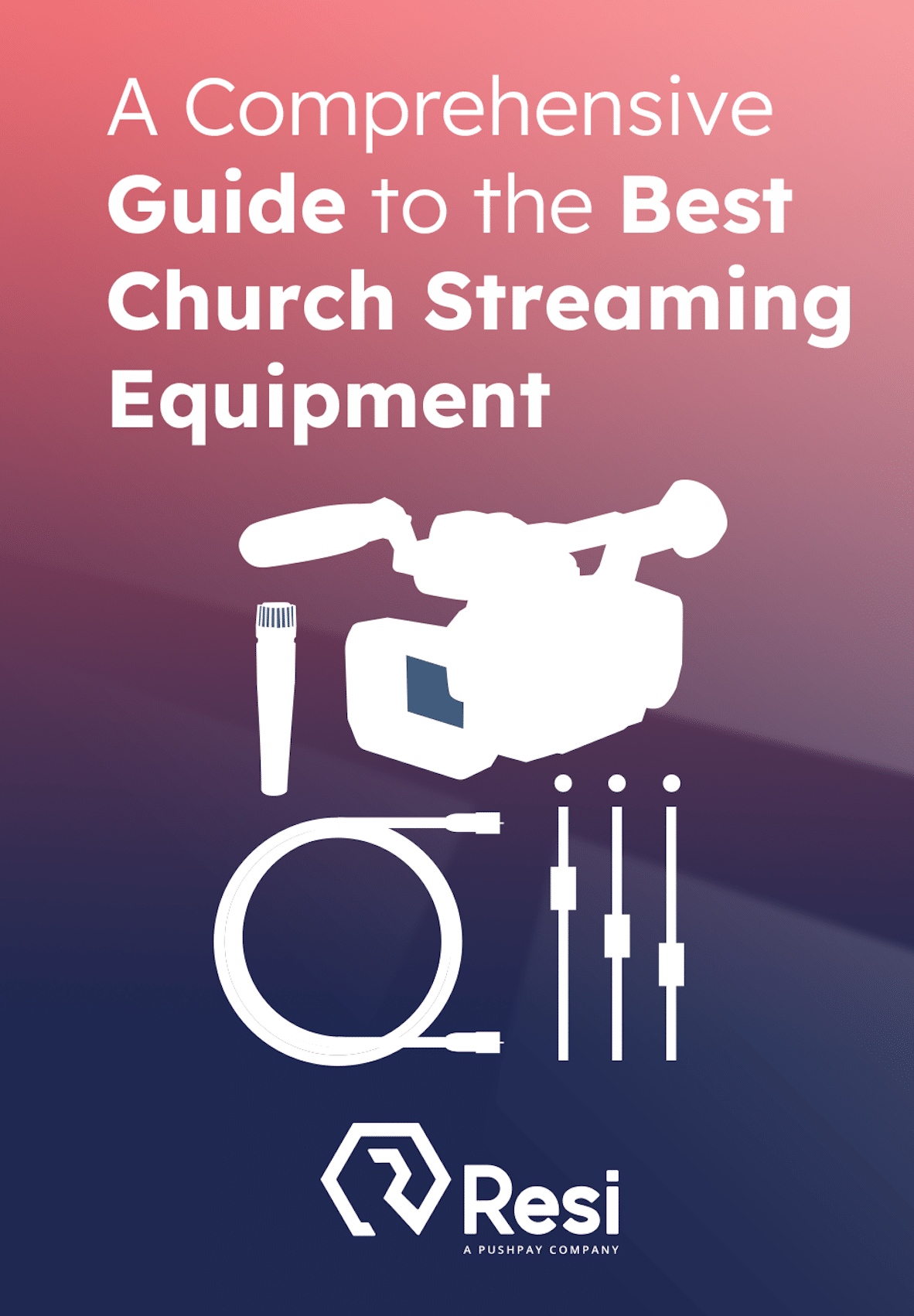
Streaming church services online has become a powerful way to extend your congregation’s reach, as streaming makes it possible for your congregants to access your services anytime, anywhere.
But the quality of that experience hinges on choosing the right streaming protocol. RTMP (Real-Time Messaging Protocol) and RTSP (Real-Time Streaming Protocol) are two leading options that each offer unique advantages. RTMP is known for its ability to handle high-performance live video streaming, while RTSP excels in real-time audio and video transmission.
Both protocols can elevate the quality of your live stream, helping your church connect with members near and far, and understanding their differences is key to making the best choice for your ministry.
What Are RTMP and RTSP?
RTMP (Real-Time Messaging Protocol) and RTSP (Real-Time Streaming Protocol) are key technologies in live streaming. These protocols handle the transmission of video and audio over the internet, ensuring broadcasts reach viewers in real time. Each has its strengths, designed to serve different streaming needs.
RTMP Overview
Originally developed by Adobe for Flash, RTMP became a go-to protocol for live streaming because of its ability to deliver low-latency video. Although its early use was centered on Flash Player, RTMP has adapted over the years and is now widely used to stream live content on platforms like Facebook and YouTube. Its structure helps maintain video quality and reduce buffering, making it ideal for events, webinars, and social media streams.
RTSP Overview
RTSP is mainly used in environments where direct control of video feeds is essential, such as IP cameras and security systems. It’s designed for applications that require real-time access with minimal delay, making it perfect for internal streams and video conferencing. RTSP is particularly useful in scenarios where immediate access to live footage is critical, offering a reliable way to manage media streams within closed networks.
Key Differences Between RTMP and RTSP
Compatibility with Streaming Platforms
RTMP is well-known for its compatibility with major streaming platforms, making it an easy choice for live streaming to YouTube, Facebook Live, and various CDN providers. Its seamless integration with these platforms allows content creators to reach large audiences without much hassle. RTSP, on the other hand, isn’t as widely used for public streaming. Instead, it shines in more specialized environments like security systems or corporate networks, where reaching the public isn’t the main priority.
Latency and Speed
When it comes to latency, RTMP is great for streaming with minimal delay to public platforms, ensuring that viewers experience content in near real-time. This is crucial for live events where immediate interaction is important. RTSP, meanwhile, is better suited for internal networks. It delivers low-latency streams in environments like video conferencing and monitoring systems, where quick access to live footage is critical.
Quality and Compression
RTMP offers solid control over video and audio quality, making it ideal for professional broadcasts where high quality is a priority. Its flexibility in adjusting compression settings also helps balance quality and bandwidth use. On the flip side, RTSP focuses more on steady, real-time streaming in local environments. It works well even with limited bandwidth, though it may offer less flexibility in compression settings compared to RTMP.
Setup and Complexity
Setting up RTMP is usually straightforward, with most public platforms offering built-in support and easy configuration options. Depending on the platform, there might be a few extra steps to fine-tune performance, but it’s generally user-friendly. RTSP, however, often requires a more technical setup. It’s typically used in specialized scenarios where understanding network configurations is important, making it better suited for users with more technical expertise.
Best Livestreaming Equipment
Discover what top-rated equipment we recommend adding to your church streaming toolkit.
Download for free!
When RTMP Is the Best Choice for Church Live Streaming
Public Live Streams to Social Media
For churches looking to engage a large audience, RTMP is a top choice. It integrates seamlessly with platforms like Facebook Live, YouTube, and Twitch, making it easy to broadcast services to a wide, diverse audience. This allows churches to effectively share their message of faith across popular digital channels, reaching people wherever they are.
Wider Audience Reach
RTMP’s compatibility with multiple platforms is a major advantage for churches that want to grow their online presence. Its versatility ensures that sermons and events can be accessed by viewers on their preferred platform, whether local or global. This makes it easier to connect with a broader audience and create a sense of inclusivity within the church community.
Control Over Video Quality
One of RTMP’s strengths is its ability to give users control over video quality and bitrate. This flexibility allows churches to maintain high standards for both video and audio, ensuring that live streams are clear and impactful. With the ability to fine-tune settings, RTMP helps churches deliver a viewing experience that reflects their commitment to sharing their message with excellence.
Resi’s Support for RTMP Streaming
Resi’s platform takes RTMP streaming to the next level by providing a reliable, high-quality solution for live streaming. With Resi, churches can easily manage their streams across multiple platforms, ensuring consistent performance without technical headaches. This allows churches to focus on what matters most—their message—while Resi handles the technical details.
When RTSP Is the Best Choice for Church Live Streaming
Internal Networks or Private Streams
RTSP is a great fit for churches that need to manage private streams or internal broadcasts. It’s especially useful for streaming services within the church’s local network or to specific areas of the building. This setup is perfect when you need a secure, controlled streaming environment that’s not intended for public viewing.
Low Latency for Internal Applications
RTSP excels in situations where real-time video is a must. It’s ideal for applications like security systems, multi-room broadcasts, or local events that need instant access to live footage. Churches can use RTSP to ensure that various parts of the building receive synchronized video feeds without the delay you might experience with public streaming.
IP Cameras and Surveillance Applications
RTSP works well with IP cameras, making it a solid choice for internal video monitoring and surveillance. Churches can use RTSP to manage overflow rooms or private sessions that need to be broadcasted within the building or over a secure network. Its seamless integration with surveillance systems ensures reliable, secure streaming for any internal needs.
Best Livestreaming Equipment
Discover what top-rated equipment we recommend adding to your church streaming toolkit.
Download for free!
How Resi Combines the Strengths of Both Protocols
Resi’s Reliable Streaming Protocol (RSP)
Resi’s Reliable Streaming Protocol (RSP) goes beyond the limitations of both RTMP and RTSP by offering a more reliable, high-quality live streaming experience. RSP is designed to handle fluctuations in bandwidth, ensuring broadcasts stay smooth even when network conditions change. For churches, this means online services can be streamed consistently without the risk of interruptions that can distract from worship.
Unified Streaming to Multiple Platforms
Resi allows churches to use RTMP for streaming to multiple platforms like Facebook Live and YouTube simultaneously, all while maintaining top-notch quality. With built-in redundancy features, Resi ensures streams aren’t interrupted, keeping the broadcast stable from start to finish. This lets churches reach a broader audience without worrying about technical hiccups, helping spread their message across different digital channels seamlessly.
Seamless Integration with On-Site Broadcasting
Resi integrates smoothly with on-site setups, including IP cameras and local networks, offering a powerful combination of real-time streaming for internal use and wide reach for online audiences. By blending RTSP’s real-time capabilities with RTMP’s broad compatibility, Resi helps churches create a unified streaming experience that connects people both inside the church and online, bridging the gap between in-person and digital worship.
Best Livestreaming Equipment
Discover what top-rated equipment we recommend adding to your church streaming toolkit.
Download for free!
Choosing the Right Protocol for Your Church’s Needs
Assessing Your Audience
Before choosing a streaming protocol, it’s important for churches to think about who they’re trying to reach. Are your viewers primarily inside the church, or are you looking to engage a wider online community? RTMP is better suited for reaching public platforms and a broader audience, while RTSP works best for localized, internal streaming. Understanding your audience’s needs will help you align your streaming strategy with your church’s outreach goals.
Considering Equipment and Budget
Your choice should also consider the equipment you have and your budget. Take stock of your current setup, including IP cameras and network infrastructure, to see if it’s compatible with RTMP or RTSP. It’s also important to factor in the complexity of the setup and the resources needed to manage each option. A well-planned budget that covers both current and future streaming needs will help you create a cost-effective, efficient system that fits your church’s capabilities.
Long-Term Streaming Goals
When planning for the long term, think about your church’s digital goals and how each protocol supports them. If expanding your online presence and reaching a global audience is a priority, RTMP might be the better option. But if internal communication and localized outreach are more important, RTSP could be a better fit. Considering how these protocols align with your future plans will help your church build a strong, sustainable streaming setup.
RTMP or RTSP Depends on Your Needs
Choosing between RTMP and RTSP is key to enhancing your church’s live streaming capabilities. RTMP is great for public platforms and broader outreach, while RTSP excels in low-latency, internal streams.
For churches looking for a blended solution, Resi’s Reliable Streaming Protocol (RSP) combines the strengths of both protocols, providing high-quality, reliable broadcasts with built-in redundancy. By using Resi, churches can easily manage both public and private streams, optimizing their digital ministry for today’s audiences.







